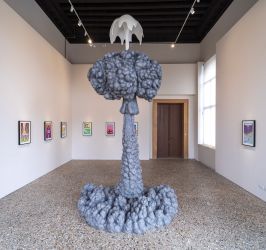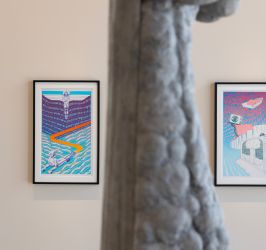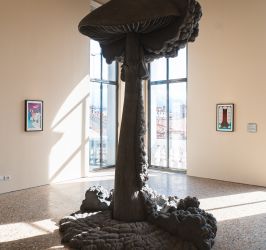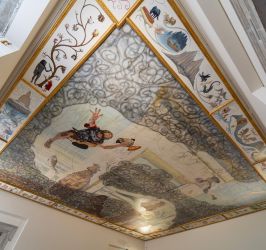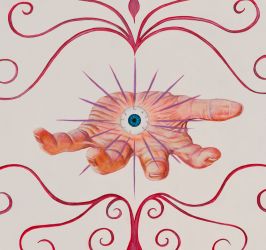Jim Shaw
1952, Midland, US
He lives and works in Los Angeles, USA
temporary artwork
The Split Fountain
2024
Acrylic paint, fiberglass, aquaresin, EPS foam, epoxy, wood and steel
The Split Fountain
#1, #2, #3, #4, #5, #6, #7, #8, #9, #10
2024
Silkscreen prints on paper
An artist with an encyclopedic, chaotic, and schizoid body of work inspired by Burroughs’ cut-up method, Shaw blurs the lines between the mainstream and the underground, mingling TV, comics, the Bible, horror films, heavy metal, gore, punk, and psychedelia. A hypertrophic panorama of themes is conveyed through an equally heterogeneous mix of styles and visual languages, always seeking a reasonable correspondence between technique and narrative content.
Influenced by epochal psychic and cultural fractures in human history, such as the discovery of psilocybin and the creation of the atomic bomb, Shaw has created The Split Fountain, a dual representation with a magic mushroom on one side and the mushroom cloud produced by the atomic bomb on the other. Alongside the sculpture, Jim presents a series of ten psychedelic prints inspired by the recorded visions and dreams of Carl Jung and McLuhan’s interpretations of Joyce’s thunderwords from Finnegans Wake.
Courtesy of the artist and Gagosian Gallery
Photos by Massimo Pistore and Matteo Catania - Hubove Studio
site-specific | permanent artwork
The Alexander Romances
2024
Acrylic on a muslin backdrop, acrylic on wood panels, and decorative wood molding
An artist with an encyclopedic, chaotic, and schizoid body of work inspired by Burroughs’ cut-up method, Shaw blurs the lines between the mainstream and the underground, mingling TV, comics, the Bible, horror films, heavy metal, gore, punk, and psychedelia. A hypertrophic panorama of themes is conveyed through an equally heterogeneous mix of styles and visual languages, always seeking a reasonable correspondence between technique and narrative content.
Taking inspiration from the myth of Alexander the Great, Jim Shaw produced a painting for the ceiling of Palazzo Diedo depicting Alexander’s anointment as the son of the God Amun in the temple at the Siwa Oasis, using an old Egyptian theater set canvas as the base. The central image, where his hyperrealist style overlaps with the original backdrop of the canvas, is surrounded by a frame of grotesques rich in symbols reminiscent of Bruegel. These symbols represent the mean and fantastical creatures that Alexander the Great during his quest to conquer the world.
Courtesy of the artist and Gagosian Gallery
Photos by Massimo Pistore and Matteo Catania - Hubove Studio. Courtesy of Palazzo Diedo
